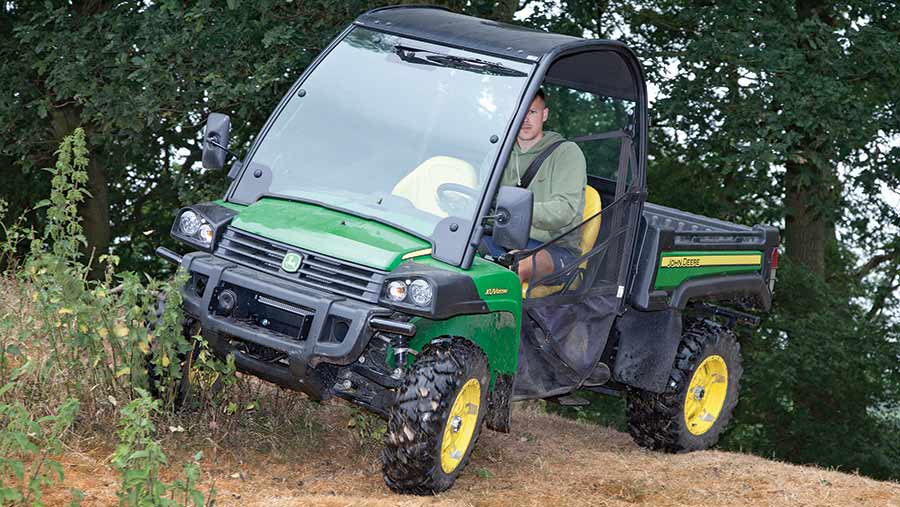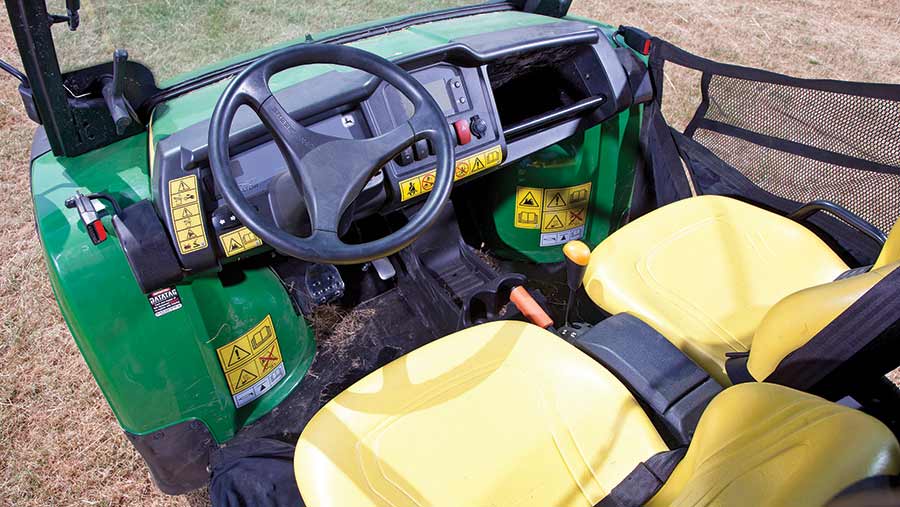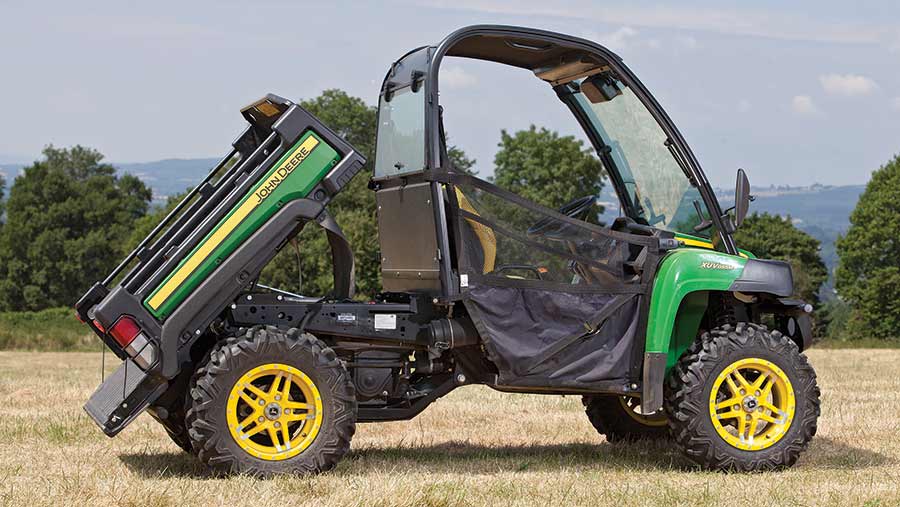On test: John Deere Gator XUV 855M buggy
 © Jonathan Page
© Jonathan Page Diesel might be the current fuel of choice for farm buggies, but there’s a new wave of petrol-powered machines looking to reverse that trend. To find out which colour of fuel is best, we put a few key players to the test.
Enter the John Deere Gator XUV 855M. The Gator’s golfing roots make it ultra-manoeuvrable and deliver a pretty languid driving style.
See also: Video: Petrol or diesel UTVs: which are best?
John Deere Gator XUV 855M
Quick verdict
Despite its flexible steering it has limited legroom which makes long hours in the seat uncomfortable.
That said, the diesel engine was far peppier than the laboured Mule – though still miles from petrol equivalents – and it handled our downhill route far better than the rest. It’s expensive, though.
Price as tested: £17,160
Best for: Going downhill
Worst for: Cab comfort
Driveline
Diesel-powered UTVs have a reputation for fairly lacklustre performance, but the Gator was livelier than expected.
At 854cc, its three-bore Yanmar engine is slightly smaller than that of the Kawasaki but, ironically, leaves the sluggish Mule looking like a bit of a donkey.
The Gator beat its old adversary by three seconds in the uphill sprint (nothing special here – they were both tortuously slow) but by almost a minute in the two-mile uphill slog. If we’d had the Kubota RTV on test then it would have been left for dead, too.
Like most of its rivals, JD fits a two-speed CVT transmission that provides a moderate turn of pace restricted to a top speed of 45kph.
Though it might sound fairly pedestrian, it’s more than adequate for most journeys and also prevents pushing the vehicle beyond its rudimentary limits.
Likes
- Very manoeuvrable
- Best engine braking
- Nippy for a diesel
- Good visibility
Gripes
- Cab fills with dust when travelling at speed
- Poor cab ergonomics
- Lack of ground clearance
- Rear bar restricts access to tow ball
The slow-and-steady Gator also took first prize in our engine braking test.
The system is engaged by gently throttling on downhill sections, where it demonstrates remarkable discipline to rarely drift past 2kph.
Cab
While the driveline might have performed better than expected, the Gator’s cab is less suited to owners clocking high hours on slug pelleting jobs and the like.
The main problem is the driver’s proximity to the front wheel arch, which leaves very little space for the left leg and means it can feel very cramped after a short time.
Passengers will also find themselves bereft of knee room and, even without a cab, the footwells get unpleasantly toasty – dissipating engine heat is the main culprit.
Whether or not to spec a sealed cab is a long-running moot point among owners. On the plus side, it minimises the dust problem, which is a big deal as the Gator tends to suck debris stirred up by the front wheels into the cockpit.
On the other hand, the shape of the frame means the top of the doors eat into shoulder room and the engine thrum tends to echo loudly, as Honda Pioneer owners will have no doubt found out.
It’s not all bad news though – despite the low driving position the visibility is surprisingly good and makes it really easy to manoeuvre, even through pretty dense woodland.
The controls are easy to find and use too, but there’s only space for two occupants – most of the others offer the flexibility of a bench seat.

© Jonathan Page
Working life
On paper, the Gator looks the least agricultural of the group. For starters, ground clearance is poor and the suspension is short of travel, which makes rides over rough, rutted ground pretty uncomfortable.
However, it can handle itself over less extreme surfaces and matches reasonable power and speed with very good balance, a low centre of gravity and the best turning circle among its rivals.
The thick, plastic load bed is solidly made and sits low, making it easy to lob in bales and bags. Steel side bars provide decent lash-down points too, but the bed can only be tipped from one side via a slightly sticky pin arrangement.
Our model also came with a rear protective bar that sits below the tailgate, which made hooking on a trailer a rear hassle. On the plus side, rear lights are cage protected and there’s a pickup-style latch on the tailgate.

© Jonathan Page
John Deere Gator XUV 855M full specs
- Engine Three-cylinder, 854cc
- Power 22hp
- Fuel Diesel
- Transmission Two-speed CVT
- Four-wheel drive Selectable two-/four-wheel drive
- Diff lock Auto locking front, mechanically actuated rear
- Suspension Dual A-arm, 20.3 travel front, 22.9 travel rear
- Brakes Four wheel hydraulic discs
- Tyres Maxxis Big Horn 27×11 rear, 27×9 front
- Rear bed dimensions 114.3 x 132.0 x 30.5cm
- Rear bed capacity 454kg
- Bed load height 83.8
- Towing capacity 680kg
- Ground clearance 22.3cm
- Dry weight 788kg (inc fluids)
- Turning circle 7.93m
- Noise, tickover 69dBa
- Noise, acceleration 85.6dBa
- Downhill loaded grass (60m, 17.5deg slope) 57.22s
- Uphill loaded grass (60m, 25deg slope) 29.29s
- Uphill loaded road (1-mile, 7.4deg slope) 3m 26s
- Starting price: £16,737

